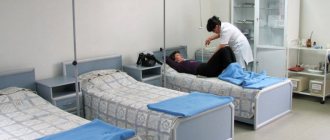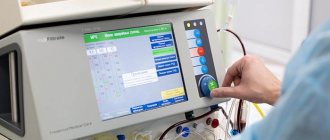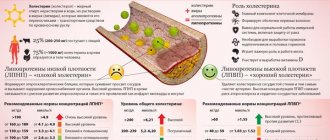How long do they stay in the intensive care unit?
Relatives are interested not only in the prognosis of the patient’s recovery, but also in how long they spend in intensive care after a stroke.
How long you will have to stay in the intensive care unit is determined by the condition of the victim. For an uncomplicated ischemic attack, when vital organs are not affected, the patient is in the department for 21 days.
They stay in intensive care longer in the following cases:
- patient after surgery for hemorrhagic hemorrhage;
- the patient is in serious condition and is on a ventilator;
- the patient did not recover from the coma;
- if it does not improve after therapy and the condition is unstable.
Often relatives hear diagnoses and do not always understand what is said correctly. Let's consider frequently asked questions from loved ones of a stroke patient:
- The condition is extremely serious, he is in intensive care: what does this mean? This term means that a person is confused or comatose and their vital signs are unstable.
- Stable severe condition during stroke: what could such an assessment mean? There is no serious cause for concern here. The term “stablely severe” means that the person is breathing independently and vital signs are within normal limits. There is a good prognosis for recovery.
Doctors cannot answer how long they are in intensive care for complicated stroke attacks. How long the resuscitation period will last depends on the victim’s body’s ability to restore functions.
Duration of resuscitation depending on the type of stroke
Treatment depends on the type of pathology. Stroke is divided into 2 types:
The patient may stay in the intensive care unit longer, but only after undergoing an examination. On the 21st or 22nd day of his stay in intensive care, a commission meets to assess the person’s physical condition. If one of the delay factors is detected, the period of stay in intensive care is increased to 30 days. In rare cases, it can be extended, but only on the basis of delay factors that are identified at the consultation.
How to treat in the intensive care unit
Treatment of stroke in intensive care significantly increases the chances of survival and recovery.
Intensive therapy is carried out comprehensively and provides:
- stabilization of vital signs;
- restoration of cerebral blood supply (drugs are prescribed to reduce blood viscosity and improve nutrition of brain cells);
- life support;
- prevention of complications (bedsores, congestive pneumonia).
What is done in intensive care after a stroke depends on the nature of the brain damage and accompanying symptoms. In severe cases, the patient may be placed on life support.
But, despite timely treatment of stroke in intensive care, it is impossible to say what the chances of survival in the early post-stroke period are. Prognosis depends not only on how it is treated, but on the patient’s body. In medical practice, there are cases where seemingly stable patients experienced a second stroke or developed other serious complications.
Neurological resuscitation is necessary to prevent or promptly detect complications arising after a stroke, increasing the chances of recovery.
Where is the patient transferred from ARC?
Relatives of a stroke patient are interested in where they are transferred after resuscitation in order to be able to visit the person and provide moral support. It depends on the severity of the brain damage:
- uncomplicated cases are treated in hospital for 3 weeks, then follow-up treatment and rehabilitation are carried out on an outpatient basis;
- in case of a severe attack, the patient is transferred from the intensive care ward to the neurological department, where he can stay for a month or longer.
If the risk of a recurrent stroke attack remains or vital signs are not stable, then the patient remains in the anesthesiology and intensive care unit (ARO).
Features of resuscitation and its timing
The ICU will maintain vital signs for three weeks in most cases. All this time, doctors support the body’s activity as much as possible and do everything to prevent the situation from worsening. The main problem at this time is the inadequate activity of parts of the brain and those structures where the consequences of an ischemic stroke remain.
When undergoing surgery due to hemorrhagic stroke, cerebral edema becomes a threatening condition, which can lead to death. The main indicators of the patient’s body and his brain are recorded by devices; if the situation worsens, doctors in the department urgently carry out resuscitation measures. Usually, within three weeks in intensive care, it is possible to avoid threatening conditions and stabilize the patients’ vital signs. In the future, care for a bedridden patient is carried out in the general ward.
Features of hospitalization for stroke are manifested in the volume of disorders that formed in the patient after acute oxygen deprivation of the brain or hemorrhage. The following factors influence how long treatment lasts:
- the location of the focus of ischemia or hemorrhage and its size - the larger the volume of damage, the longer the patient remains under treatment;
- severity of clinical signs of pathology;
- degree of depression of consciousness - for example, in a comatose state, a stroke patient is placed in intensive care and will not be placed in the intensive care ward until consciousness returns to him;
- level of preservation of vital functions;
- monitoring blood pressure readings to avoid relapse of an attack;
- presence of additional complications.
Treatment for stroke in intensive care has two directions: patients are given basic therapy, as well as specific therapy, depending on the needs of each patient.
Basic therapy includes respiratory and hemodynamic support. It is very important to combat possible cerebral edema, which can cause death, to prevent vomiting and psychomotor overexcitement. At the same time, the patient’s nutrition is adjusted and hygienic care is provided.
Specialized care for hemorrhagic stroke depends on the patient’s condition; at the initial stage, pressure correction is achieved and surgical intervention is performed. For ischemic stroke, help is aimed at reducing hypoxia and activating metabolic processes. If help was provided in a timely manner, the length of stay in the clinic is reduced. It is difficult to talk about how long intensive care will take and when the patient will be transferred to the department. It all depends on the extent of the damage and the body’s recovery capabilities. Typically, recovery is faster in younger people.
Duration of inpatient treatment
Relatives have already found out which department the stroke patients are in and even managed to visit the patient. And now relatives are interested in how long they are in the hospital after a stroke.
According to the law, the patient has the right to remain in a hospital until the health-threatening abnormalities disappear:
- A microstroke is treated for 21 days in a general ward.
- A condition of moderate severity, which occurs after an ischemic stroke with right paralysis or moderate hemorrhage, will require inpatient therapy for 3-4 months. In case of a stroke with paralysis of the right side, it is necessary not only to stabilize the patient, but also to carry out primary rehabilitation measures.
- Slow recovery after a hemorrhagic stroke complicated by paralysis on the left side; the time spent in hospital can last up to six months. After a stroke with left paralysis, a person in serious condition often develops complications related to the functioning of the heart.
If a person is in a coma, it is impossible to say how long he will remain in the hospital. Some patients remain unconscious for months and are dependent on medical personnel. Such a person is not discharged from the department.
How long you stay in the hospital after a stroke depends on how long the recovery after the acute period lasts. After discharge, working people are kept on sick leave for several months, giving them the opportunity to complete their rehabilitation course on an outpatient basis.
Main stages of therapy: timing and features
In case of stroke, assistance to patients can be divided into several stages:
- pre-hospital care – provided by others or a team of doctors before admission to a medical facility;
- providing assistance in the clinic - performing an operation or treatment in the intensive care unit, intensive care unit;
- the patient's stay in the general ward.
If we can say about the first two stages that the length of stay there is unpredictable and depends on the health of the patient and his condition after the operation, then the third stage is regulated by law. There are instructions from the Ministry of Health, according to which stroke patients, after passing through the acute period, are transferred to a general ward, the duration of stay in it is from 21 to 30 days.
Patients whose vital functions are not impaired are kept in an intensive care ward for three weeks. Simply put, these are those patients with a mild form of stroke whose body has found the strength to restore activities that were not seriously affected.
Stroke patients with more serious disorders, whose body was unable to overcome the abnormalities caused by the stroke, remain in a stable and serious condition for 30 days. If even after thirty days in the clinic the patient’s condition does not improve, a medical and social examination is carried out, recording the condition of the stroke patient after the end of the expected recovery, the extent of the remaining disorders, and their threat to human life. The conclusion of the medical and social examination is a decision on the advisability of the patient’s continued stay in the clinic, drawing up a plan for the patient’s recovery.
Inpatient therapy
Treatment methods for stroke in a hospital differ from those used in ARC. The standard of treatment for stroke in a hospital consists of the following measures:
- drug therapy aimed at restoring brain functions;
- rehabilitation.
Rehabilitation activities include physiotherapy, massage, exercise therapy. Patients with speech disorders receive additional treatment from a speech therapist.
How stroke complications are treated depends on the nature of the abnormalities that arise. The nature of the attack has almost no influence on the prescribed therapy. Treatment of ischemic stroke and hemorrhagic lesions follows a similar scheme.
How many days the therapy will continue depends on the prescribed course of treatment. Typically, the treatment period for ischemic stroke is slightly shorter than after cerebral hemorrhage.
Stroke. We are being discharged from the hospital
Free consultation on treatment in Moscow. Call or fill out the form below:
We are often asked for advice with this question. Indeed, relatives and the patient himself are often left to their own devices. As such, there is no state rehabilitation program yet. Moreover, we also do not have a universal answer.
One thing we know for sure is that all patients and their relatives have the same goal: a speedy restoration of function and a return to normal life. The goal is one, but the paths to it are different, often long and, sadly, dead-end...
When treating a stroke, the situation very often develops as follows. A man is admitted to the hospital. The life of family and friends changes dramatically. Anxiety for a loved one, changes in work schedule, financial costs for medications, caregivers and consultations. And when you get discharged, it turns out that everything is just beginning: equipping an apartment, hiring caregivers, or temporarily stopping work for one of your relatives. And the prices for rehabilitation make you feel uneasy...
Yes, everyone’s financial capabilities are different! Yes, many people have to rely only on themselves! Yes, there are no clear and understandable government programs, for example, for a heart attack!
Let's try to calculate everything ourselves and make the right decision.
Americans, for example, are a mercantile people and far from stupid. They once calculated that every dollar invested in treatment, without further rehabilitation, turns into 17 dollars spent in the future. Let's just count in money. It is important. Just numbers Average monthly drug treatment for stroke: from 2 to 7 thousand rubles.
Depending on the degree of dysfunction, complications and concomitant pathologies. Let's add to this a nurse or the financial losses of relatives if they are present and caring for the patient. Another 20-30 thousand monthly. All methods of motor and speech rehabilitation cannot be implemented on your own. Whatever one may say, at the first stages you will have to invite specialists. Preferably at least. There are a lot of subtleties, no matter what they write on the Internet. This is also money. Now all that remains is to add up all these numbers and multiply by the number of months. At 6 for example...or at 12...
The numbers may, of course, vary. There are different types of strokes. And if you don’t look at the numbers, but think about the time for effective rehabilitation, which we already have little of. In the end, we need to put our loved one back on his feet. Return to society, learn to drive a car again. And this is possible in modern conditions. So it turns out that the amounts are ultimately comparable, but the effects and results are radically different.
If you have read this far and haven’t given up on this idea without taking our word for it, let’s look for solutions and minimize costs.
If you or your loved ones need medical assistance, contact us. The site’s specialists will recommend a clinic where you can get effective treatment:
What to bring to the hospital
Relatives do not always know what can be brought to the hospital after a stroke and often forget necessary things and bring prohibited food.
You can bring to the hospital:
- Toilet supplies (soap, toothbrush, comb).
- Change of clothes.
- Diapers. Even if a person with a stroke goes to the bathroom on their own, at night, due to the inability to quickly get out of bed, an annoying nuisance can occur. This usually occurs in older people.
- Convenient dishes. It is difficult for a patient after a stroke to drink from a glass, and a drinking cup can improve the comfort of self-service.
- Homemade food. People with hemorrhagic stroke or after acute ischemia need to follow a diet. But, despite the fact that the hospital provides adequate food, homemade food seems tastier. From food you are allowed to bring boiled cutlets, vegetable and fruit purees, stewed meat and fish without spices.
If the patient is bedridden, it is recommended to bring large wet wipes. This will make it easier to carry out hygienic treatment when changing diapers.
How much sick leave after a stroke?
1.1. The law does not set deadlines. The timing is determined by doctors, if necessary. The law simply determines the timing of payment of benefits in different cases, in particular in this one. See Art. 6. Federal Law “On compulsory social insurance in case of temporary disability and in connection with maternity” dated December 29, 2006 N 255-FZ.
The sheet can only be obtained by a close relative or guardian. Sick leave to care for a close relative is issued only in the event of a threat to the life and health of the patient, as well as in the absence of an alternative in choosing a person who can provide proper care.
Hospital care after resuscitation
Care after a stroke in the hospital is provided by junior medical staff:
- bedridden people are washed and spoon-fed;
- persons whose capabilities are moderately limited are assisted in performing hygiene procedures.
But this does not mean that once you know which department you are admitted to for a stroke, you should limit yourself to visiting a relative. Rehabilitation after resuscitation will be more successful and the recovery prognosis will improve if the stroke patient feels cared for by loved ones.
Although staff provide professional stroke care, it is important to help the person bathe, change clothes or style their hair, and bring home-cooked meals. Attention and care are very important in the post-stroke period.
How long do they stay after a stroke?
— You have signs of damage to the cervical spine. You need to see a neurologist, and the doctor will prescribe treatment for radicular manifestations. I think the specialist will definitely ask you to do an X-ray of your neck. It is dangerous to treat spinal pathology without an image. I know cases where, after visiting a chiropractor, people were overcome by paralysis. Recently, a man came in who had a destroyed vertebra. The patient suffered from multiple myeloma (a blood disease that affects the bones), which caused pain, and rushed to seek help from a chiropractor. And he undertook to treat without x-rays.
- Either a physical therapy doctor or a kinesiotherapist. In the early rehabilitation ward, specialists work with the patient, and relatives observe and learn. The doctor shows: you need to start the massage with your fingers - stretch each joint several times, then the hand, elbow, shoulder... The sooner the patient starts performing simple movements, the faster he will move on to more complex ones: writing with a pen, dressing, washing. In case of a stroke, it is important to exercise the affected arm and leg to avoid restriction of joint mobility (pathological contracture). Due to malnutrition, inflammation, tissue degeneration, and arthrosis with contracture may begin in the joint. The joint hurts, the hand does not obey, and it is difficult to restore its former performance. To avoid complications, you need to massage and do exercises every day. More information about how to care for a patient who has suffered a stroke can be found in the Department of Neurology No. 2, which is located in Kyiv, on Baggoutovskaya Street, 1. Telephone 0 (44) 483−16−94 .
Sick leave
Inpatient treatment only stabilizes the health condition, and then the person receives further treatment at home. A sick leave certificate after a stroke is opened in the hospital, and after discharge the stroke patient renews the document by visiting a doctor.
The duration of disability depends on the nature of the brain lesion:
- mild ischemic stroke is treated for about 3 months;
- a patient after surgery for removal of an intracranial term requires a minimum of four months of rehabilitation.
Sick leave after a stroke can be extended to 7-8 months. After this time has expired or if the doctor sees that full rehabilitation is impossible, the patient is sent to MSEC to receive disability.
Resuscitation in the early post-stroke period is one of the important stages of rehabilitation treatment. Intensive therapy helps prevent brain swelling and reduce the lesion. If a person has been taken away with a diagnosis of stroke, then there is no need to look for which department to treat stroke - patients after an acute attack are hospitalized in the ARC.
Factors for prolonging intensive care
A patient with an ischemic or hemorrhagic stroke may remain in intensive care for long-term treatment if:
- a relapse occurred (repeated damage to various parts of the brain);
- human life and health are still under serious threat;
- the person did not come out of the coma;
- the affected parts of the brain did not recover during rehabilitation;
- there are signs indicating an imminent recurrence of the attack.
The purpose of a patient's stay in the intensive care unit is to preserve life and restore nervous functions at the brain level. If the patient still needs reconstructive surgery, he is kept in intensive care, where care is provided for recently operated patients.
The recovery period depends on resuscitation treatment. The period of time during which the basic procedures will be prepared and performed directly affects the speed of the patient’s rehabilitation.
When a person is admitted to the intensive care unit, the following steps must be taken:
- correction of respiratory system dysfunction;
- reduction of unreasonable psychomotor agitation;
- restoration of the normal state of the body (combat hyperthermia);
- compensation for brain swelling.
After an emergency examination, surgery is prescribed or special equipment is used. In case of hemorrhagic stroke, surgery is required to eliminate life-threatening edema, during which the edematous fluid is removed and the pressure of the edema on important parts of the nerve center is compensated. Surgical intervention is urgent and should be carried out no later than the second day of the patient’s admission to the hospital. If the operation was delayed by 3–4 days, rehabilitation will be delayed.
Ischemic stroke does not always require surgery. Its clinical symptoms are compensated by the work of special life support units, outpatient and resuscitation procedures. The recovery period is several days shorter than with surgery.











